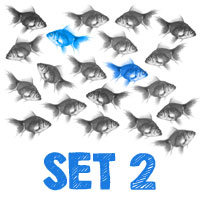
Signs That Are Close... But Not the Same - Set 5
This article is part of our “Signs That Are Close... But Not the Same” series, which highlights signs that look similar, but have different meanings.
The ASL signs shown below look similar, but are not the same. There are many ASL signs that when produced look similar, but in fact have a completely different meaning. Below you will find examples of such signs. Watch closely to see if you can see the differences. In addition, watch my eyebrows, look to see when I tilt my head or lean my body in a certain way, even what my mouth is doing. These nuances are called inflections and trust me, inflections matter.
1. Satisfy vs. Relief
The handshape and palm orientation are the same when signing SATISFY and RELIEF - they both use B-hands with the palms down and the dominant hand is higher. When signing SATISFY, think of both hands settling on your midsection in satisfaction and bring your two hands back to your body. When signing RELIEF, the hands move downward, like you are experiencing the settling feeling of relief.
 |
2. Complicated vs. Very ugly
Again, these signs use similar handshapes and palm orientations - both signs changing between using index fingers and X-hands. However, if you pay attention to movement and the start and end locations of the signs COMPLICATED and VERY UGLY, you won’t have a problem telling them apart. VERY UGLY starts under the nose and pulls out in a swift movement as they change into two X-hands. You could think of an ugly mustache or ugly facial expression to remember the sign for VERY UGLY. COMPLICATED starts in the opposite position, with the hands out, away from the face and then move in toward the nose while wiggling between index and X-handshapes. You can remember when signing COMPLICATED that the hands are coming towards each other and becoming entangled or complex/complicated.
 |
3. Semester vs. System
SEMESTER and SYSTEM both have the S-hand start in front of the body and then move out and down. The big difference between these two signs is SEMESTER uses one hand, while SYSTEM uses two. Think of system using two hands to represent two sides of the system.
 |
4. Game vs. Challenge
When signing GAME, both 10-hands start out, then come straight in and touch twice. CHALLENGE also uses 10-hands but they come in with a single sweeping motion. To remember which sign to use, think of the two movements in GAME to be more playful, symbolizing playing a game, while the hands sweep in to accept the CHALLENGE.
 |
5. Electricity vs. Physics
The hands both come together and tap twice when signing ELECTRICITY and PHYSICS (and also GAME in the example above!), but ELECTRICITY uses X-hands, while PHYSICS uses bent V-hands that also intertwine as they meet. Think of the single fingers of the X-hands meeting when signing ELECTRICITY as two electrical wires being joined to create electricity. Think of PHYSICS using V-hands that intertwine as they meet to represent properties, such as matter and energy, coming together when studying physics.
 |
How can I figure out the difference between signs on my own?
If you see two signs that look close, but not the same, and you’re not sure, you may use Signing Savvy features to help you figure out the difference. All of our signs have sign descriptions and memory aids that members may access. Reading the sign description and memory aids for the signs will help you figure out the small differences between them that your eyes don’t catch at first. We also recommend using the pause and slow motion feature to slow down the video, so you may take a closer look. These features are available to Signing Savvy members.
Take a look, it's in a book!
These examples are aligned with the Visual Discrimination section of Lesson 9 (page 109) from Lessons and Activities in American Sign Language by Brenda E. Cartwright and Suellen J. Bahleda. Check out the book for more ASL Activities and watch for more examples from this series: “Signs That Are Close... But Not the Same.”
Resources
Signing Savvy is a participant in the Amazon Services LLC Associates Program, an affiliate advertising program designed to provide a means for sites to earn advertising fees by advertising and linking signingsavvy.com to Amazon properties. That means Signing Savvy may contain affiliate links. If you make a purchase after clicking on an affiliate link, your cost will be exactly the same regardless, but Signing Savvy will automatically receive a small commission. Your support is greatly appreciated and helps us continue to improve Signing Savvy!
ADVERTISEMENTS
 Brenda Cartwright is a Coda, seasoned interpreter, a master teacher, well known presenter, and author of several best selling sign language and interpreting textbooks from the RID Press. For 35 years Brenda was the Chair of the Sign Language Interpreter Program at Lansing Community College in Lansing, Michigan.
Brenda Cartwright is a Coda, seasoned interpreter, a master teacher, well known presenter, and author of several best selling sign language and interpreting textbooks from the RID Press. For 35 years Brenda was the Chair of the Sign Language Interpreter Program at Lansing Community College in Lansing, Michigan. Signs That Are Close... But Not the Same - Set 1
Signs That Are Close... But Not the Same - Set 1 Signs That Are Close... But Not the Same - Set 2
Signs That Are Close... But Not the Same - Set 2 Signs That Are Close... But Not the Same - Set 3
Signs That Are Close... But Not the Same - Set 3 Signs That Are Close... But Not the Same - Set 4
Signs That Are Close... But Not the Same - Set 4 Signs That Are Close... But Not the Same - Set 6
Signs That Are Close... But Not the Same - Set 6







Savvy User DoryFriday, March 24, 2017
Hi! I was at the aslpro.com website to see what the sign for ENTIRE was. I thought maybe FULL or ALL. They didn't have the sign for ENTIRE on their site. But they had a Google Search box and it led me here. Then I saw this blog post and I was like, "OMG... um... is that Brenda from The Land?!?!" Is it?!?!
Dory